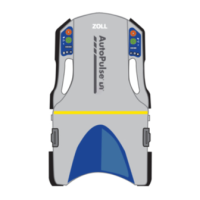Chapter 1. Introduction
AutoPulse NXT User Guide 1
1. Introduction
This user guide describes the AutoPulse
®
NXT Resuscitation System (system), operating steps, warnings, cautions,
and maintenance.
Proper use of the system requires a thorough understanding of the product, appropriate training, and
practice.
Read this user guide before operating the system, and retain it for future reference.
This chapter provides information on:
• AutoPulse
®
NXT "System description" (page 1)
• “Intended purpose” (page 1)
• "Indications for use" (page 1)
• "Intended users" (page 2)
• "Intended patients" (page 2)
• "System components" (page 2)
• "Adjunctive therapies" (page 3)
System description
The AutoPulse NXT Resuscitation System is a portable system that performs automated chest compressions.
The system can adjust to different patient sizes and can operate in environments with limited space, such as
moving vehicles.
The system may be a reasonable alternative to conventional Cardiopulmonary Resuscitation (CPR) in specific
settings where the delivery of high-quality manual compressions may be challenging or dangerous for the pro-
vider (such as, limited rescuers available, prolonged CPR, during hypothermic cardiac arrest, in a moving vehi-
cle, in the angiography suite, during preparation for ECPR).
1
Intended purpose
The AutoPulse NXT system, is intended to perform automated chest compressions on adult patients in cases of
clinical death where chest compressions are likely to help the patient.
Indications for use
The AutoPulse NXT Resuscitation System is intended to be used as an adjunct to manual CPR, on adult patients
only, in cases of clinical death as defined by a lack of spontaneous breathing and pulse. The AutoPulse NXT
system must only be used in cases where chest compressions are likely to help the patient.
The AutoPulse NXT system is intended for use as an adjunct to manual CPR when effective manual CPR is not
possible (e.g., during patient transport or extended CPR when fatigue may prohibit the delivery of effective/
consistent compressions to the victim, or when insufficient EMS personnel are available to provide effective
CPR).
1. Panchal AR, et al.
Circulation
. 2020;142(suppl 2):S366–S468

